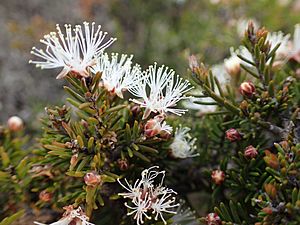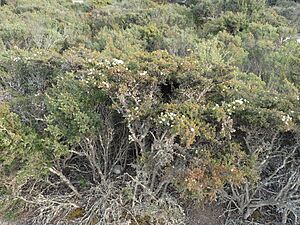Melaleuca haplantha facts for kids
Quick facts for kids Melaleuca haplantha |
|
|---|---|
 |
|
| Melaleuca haplantha growing near Ravensthorpe | |
| Scientific classification | |
| Genus: |
Melaleuca
|
| Species: |
haplantha
|
Melaleuca haplantha is a type of shrub that belongs to the myrtle family, called Myrtaceae. It grows only in the south-west part of Western Australia. This means it's endemic there, which is a fancy word for "found nowhere else naturally." Scientists first officially described this plant as a new species in 1988. A botanist named Bryan Barlow was studying a similar plant, Melaleuca cuticularis, and discovered that it was actually 13 different species, including Melaleuca haplantha!
Contents
What Does Melaleuca haplantha Look Like?
Melaleuca haplantha is a shrub that spreads out. It has bark that feels like paper. This plant can grow to be about 2 metres (6.6 feet) tall.
Leaves and Flowers
Its leaves are arranged in a special way. They grow in opposite pairs, with each pair turned at a right angle from the one below it. This pattern is called decussate. Each leaf is about 3.6 to 10.6 millimetres long (about 0.14 to 0.42 inches). They are also quite narrow, about 0.7 to 2.2 millimetres wide (about 0.03 to 0.09 inches). The leaves are shaped like a line or a very narrow oval, and they get thinner towards the end.
The flowers of Melaleuca haplantha are white or creamy-yellow. They grow in small groups at the ends of the branches. Often, the branches keep growing even after the flowers have bloomed. Each flower cluster is about 10 millimetres (0.39 inches) across. Usually, there is only one flower in each cluster, but sometimes there can be up to three. Each flower has five groups of stamens, which are the parts that produce pollen. There are about 17 to 24 stamens in each group.
Reproduction and Fruit
This plant usually flowers during spring. After the flowers, it produces fruit. These fruits are woody capsules, which are like small, hard seed pods. They are about 4 to 5.5 millimetres (0.16 to 0.22 inches) long.
How Melaleuca haplantha Got Its Name
The plant Melaleuca haplantha was officially named in 1988 by Bryan Barlow. He wrote about it in a scientific journal called Australian Systematic Botany.
Meaning of the Name
The second part of its scientific name, haplantha, comes from Ancient Greek words. "Haplos" means "single," and "anthos" means "flower." So, haplantha means "single-flowered." This name refers to how the plant usually has only one flower in each cluster.
Where Melaleuca haplantha Lives
This melaleuca plant is found in several areas of Western Australia. These include the districts around New Norcia, Mukinbudin, the Stirling Range, and Hopetoun.
Habitat
It prefers to grow in clay soil or gravelly loam. These are types of soil that can get quite wet during winter. You can find it in areas called kwongan (a type of shrubland) or in woodlands. These regions are part of specific natural zones in Australia, known as biogeographic regions.
Is Melaleuca haplantha Endangered?
The Government of Western Australia's Department of Parks and Wildlife keeps track of plants and animals. They have listed Melaleuca haplantha as "not threatened." This means that, for now, there are enough of these plants in the wild, and they are not at risk of disappearing.


